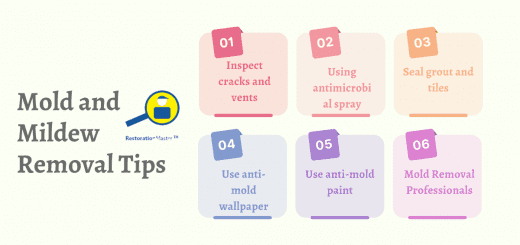How to Pick the Right Wet Room Flooring
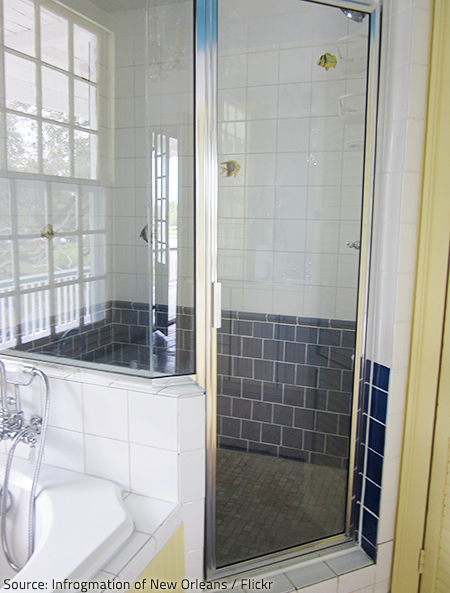
A wet room adds luxury and style to your home.
If you’re looking for a way to open up your bathroom and create a more luxurious space, add a modern feel to your home, or upgrade your living space with a stylish and attractive design feature, you may be considering a wet room. Yet, you may not be sure whether it will work in your home and if it’s going to suit your needs and preferences. In fact, a wet room can perfectly match the overall design of any house and provide a practical and efficient bathing space – as long as it is properly planned and implemented.
So, when designing a wet room, you need to choose a layout, materials, and style that will be appropriate for the available space and will not only look good, but will also function well. To be able to make the right choice, you need to take a number of relevant factors into account and carefully research your options. Here is what you need to know:
What Is a Wet Room?
A wet room is a waterproofed area that can have a shower installed without the need for a conventional shower tray. Instead of common bathroom fixtures, such as bathtubs and glass screens, it consists of an open shower space with a shower drain inset into a gently sloped floor.
Wet rooms offer several benefits over traditional bathrooms – they are more accessible, easier to clean, and create the sense of a much bigger space. Besides, they’re very attractive and can greatly increase the value of your home.
What to Consider When Designing a Wet Room
There is no doubt that you’ll want the perfect wet room for your home. To be able to create it, you need to take a number of important things into consideration before you start your project:
Waterproofing
The most essential thing about a wet room is to ensure that it is properly waterproofed (“tanked”) in order to prevent moisture migrationMigration is the movement of water, contaminants, or air fro... More and leaks. Tanking is a waterproofingWaterproofing is the application of materials or coatings de... More procedure that involves priming the floor, the lower section of the walls, and the entire wall area around the shower. The primed surfaces are covered with a self-adhesive membrane that has a thick rubberized waterproof layer containing a glass fiber mesh on one side for extra protection against moisture.
Water drainage
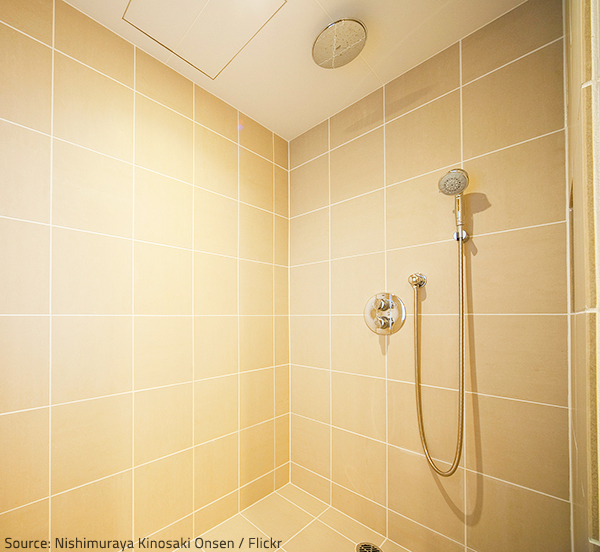
Your new wet room needs to be properly tanked in order to prevent moisture problems in your home.
In order to ensure effective water drainage, a gradient needs to be created along the floor to channel the shower water into a drain. The most common method for forming a gradient is to install a sub-floor made from plywood, which creates a “fall” towards the drain. Another option is to install a ready-made sloping shower former (pre-formed wet room tray) that slopes towards a drain. Keep in mind that the position and the style of the drains you choose for your new bathroom space (linear drain panels, modular drain systems, etc.) will influence the selection of materials and styles appropriate for your wet room flooring.
Safety
Safety should be your primary concern when designing a wet room. This is especially important in regard to the flooring – all floors used in wet rooms should be non-slip and offer a good grip in order to reduce the risk of accidents and injuries. So, when choosing a floor for your wet room, make sure you choose anti-slip tiles, vinylVinyl is a durable synthetic plastic material commonly used ... More or rubber floors with a high slip resistance rating, or other types of flooring that meet the safety standards.
Size
If you have a large space, you can create a luxurious wet room – install a bold feature wall, tile the entire shower area with fascinating mosaics, use elegant dark colors, etc.
If the available space is small, however, you need to be more careful with your choice of materials, styles, and colors – it’s a good idea to use larger tiles or floor panels to create the illusion of a bigger room and light colors to open up the space (using the same tone on floor and walls with a splash of interest in streaks of vivid color can be a clever way to maximize the appearance of space). Besides, you’ll need a floor that adapts easily – some wet room floor panels are quite bulky (which makes them perfect for open spaces, but inappropriate for tight rooms with multiple corners).
Make sure you also consider the existing plumbing system and how your new wet room will connect with it. Some shower panels and floor panels can be cut and curved around existing pipework to eliminate the need for removing the old pipes and installing new ones. If you’re having new pipes fitted, inform your plumber about your wet room design in advance, so that you can together create the most efficient solutionA solution is a homogeneous mixture of two or more substance... More for your new bathing space.
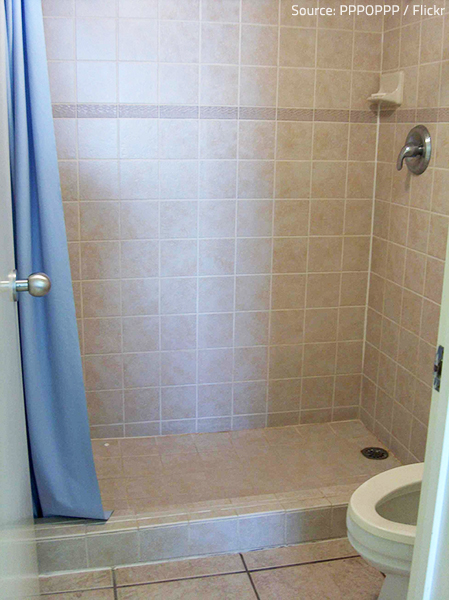
Large tiles and light colors can make the space look bigger and brighter.
Users
If you have young children, you will need a “softer” floor which can withstand frequent splashes and puddles of water. Slip resistance is also an important factor. In this case, rubber or vinylVinyl is a durable synthetic plastic material commonly used ... More wet room flooring may be the most suitable options – they are hard wearing and highly resistant to water. What’s more, they offer a soft underfoot in the event of falls. You can even create a more playful and fun design scheme due to the diversity of colors and patterns of rubber and vinylVinyl is a durable synthetic plastic material commonly used ... More panels.
If the wet room will be used by elderly people, it needs to be easily accessible, easy to maintain, and with a good level of slip resistance (a softer surface is also preferable). VinylVinyl is a durable synthetic plastic material commonly used ... More flooring is your best choice.
Style
Needless to say, you should choose a wet room design that matches the rest of your interior décor and reflects your personal style and aesthetic preferences. The vast choice of materials, colors, and patterns means that you will be able to create the exact look and feel you want for your wet room – from sleek, modern appearance to a warm, luxurious look.
Wet Room Flooring Options
One of the most important decisions to make when designing a wet room is what type of floor to use in your new bathing space. You can choose from several different wet room flooring systems, each of which has its own specific advantages and disadvantages:
Wet Room Floor Tiles
Tiles are the most popular choice for a contemporary wet room. Available in a wide variety of materials, textures, and styles, tiles provide great versatility and considerably enhance the aesthetic appeal and practical functionality of a wet room. What’s more, they can be installed on any floor build up and work very well with the most advanced drainage and waterproofingWaterproofing is the application of materials or coatings de... More solutions available on the market.
Ceramic
Waterproof, durable, and available in many colors, sizes, and styles, ceramic tiles are one of the most popular options for wet room flooring. They are made from clay, sand, and water that have been fired in a kiln to great density and hardness. The tiles are then finished off with a customizable colored surface. When choosing ceramic tiles for wet room floors though, make sure you pick textured tiles for more secure footing.
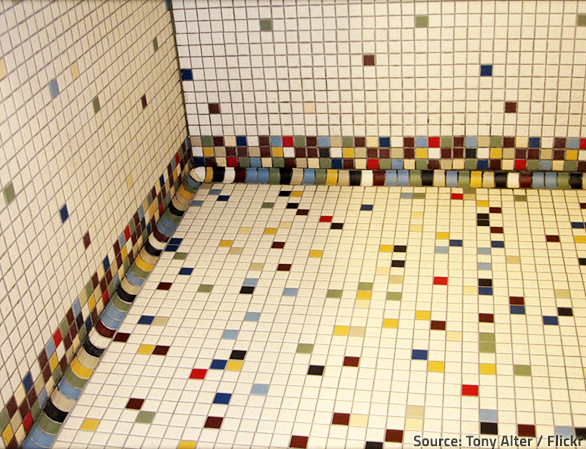
A tiled wet room can have a truly amazing look.
Ceramic is naturally resistant to stains and general wear-and-tear which makes ceramic tile flooring easy to clean and long-lasting – a great choice for a wet room.
Porcelain
Porcelain is made from denser clays than ceramic and fired for longer and at a higher temperature, so it is hardier and less porousPorous describes a material that contains small openings or ... More. It doesn’t require sealing and provides excellent protection against moisture. Porcelain tiles are hardwearing, impervious to water, stain-resistant, easy to clean, and available in many finishes. They provide a durable, hygienic surface and can simulate the look and feel of natural stone materials.
When choosing porcelain tiles for your wet room, keep in mind that they can come glazed or unglazed – glazed tiles do not need to be sealed when installed (unglazed do) but they are vulnerable to chipping. Unglazed tiles require sealing but they’re less slippery and therefore – safer.
Natural Stone
Natural stone tiles are the most stylish and luxurious choice for wet room flooring. The most popular options include marble, granite, slate, travertine, and limestone. All stone tiles are very hardwearing and stunningly beautiful. However, they are much higher maintenanceMaintenance is the routine care, inspection, and repair of a... More than other durable wet room floor materials, such as porcelain or vinylVinyl is a durable synthetic plastic material commonly used ... More:
- All stone is porousPorous describes a material that contains small openings or ... More, to a greater or smaller extent, so stone tiles require sealing prior to installation and regular resealing every couple of years;
- Although stone is very durable, it needs to be properly cared for (with the right cleaning products and techniques) in order to preserve its gorgeous look and feel for a long time.
Mosaics
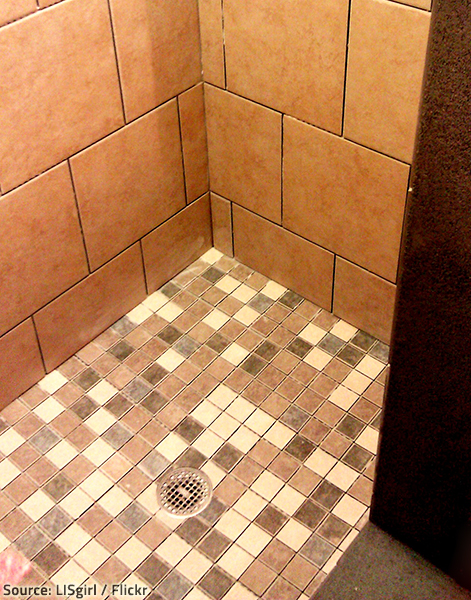
Mosaic tiles are one of the most popular and most appropriate options for wet room flooring.
Mosaic tiles are small stone or glass tiles combined together to form an intricate pattern. They are available in a wide range of colors and sizes and allow for a lot of creativity, elevating the style and sophistication of a wet room.
Mosaic wet room floor tiles provide a high degree of slip resistance because of the numerous grout lines between them which can act as a gulley and help the water disperse. Besides, small mosaic tiles are much easier to be maneuvered into place where sloping is required (such as when the drain is in the center of the room, for example).
However, since mosaics require more grouting than larger tiles or floor panels, mosaic floors are more difficult to maintain in pristine condition.
Good to remember: When choosing tiles for wet room floors, make sure you:
- avoid tiles with a gloss or highly polished finish as they’re more likely to become slippery when wet;
- keep grout lines tight (grout will eventually let moisture through, even when sealed) and look for grouts that contain additives to reduce moisture penetration;
- use cleaning products which are recommended by the tile manufacturer (some cleaners can be abrasive and damaging to the tiles);
- consider underfloor heating, as tiles can be cold and unforgiving underfoot.
Vinyl Flooring for Wet Rooms
Cost-effective, easy to clean, and available in a plethora of colors and styles, vinylVinyl is a durable synthetic plastic material commonly used ... More is gaining more and more popularity as a premium wet room flooring material. You have several options to choose from:
- Sheet vinylVinyl is a durable synthetic plastic material commonly used ... More is very low maintenanceMaintenance is the routine care, inspection, and repair of a... More and extremely water-resistant as it has very few, if any, seams that can let moisture through;
- VinylVinyl is a durable synthetic plastic material commonly used ... More planks and the so called “luxury vinylVinyl is a durable synthetic plastic material commonly used ... More tiles” can mimic the look of wood or stone and create an elegant, luxurious atmosphere in the bathing space. High-quality vinylVinyl is a durable synthetic plastic material commonly used ... More brands feature moldMold is a type of fungus that grows in damp or humid conditi... More and mildewMildew is a type of fungus that grows on damp surfaces, typi... More inhibitors and have waterproof guarantees and lifetime slip resistance warranty.
Wet room vinylVinyl is a durable synthetic plastic material commonly used ... More flooring is hardwearing and softer underfoot than stone or porcelain tiles. It combines aesthetics with great technical performance and offers a number of considerable advantages over all other types of flooring options, making vinylVinyl is a durable synthetic plastic material commonly used ... More flooring for wet rooms such a smart and trendy choice.
Wet Room Rubber Flooring
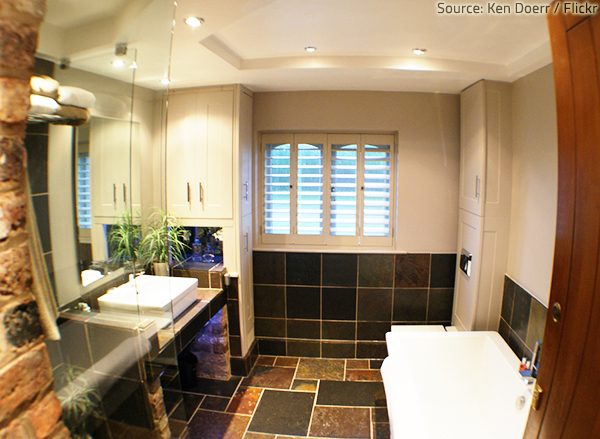
You have a great choice of wet room flooring materials and styles – pick the best ones for you.
Durable, water resistant, and available in a wide range of colors, patterns, and textures, rubber is a great option for slip resistant wet room flooring. Wet room rubber flooring is tough wearing, warm and soft underfoot, shock absorbent, and easy to clean. It is perfect for creating a hygienic surface – rubber can be fitted as one single sheet, so that there are no joins for dirt to gather in. Keep in mind though, that a single piece cannot be easily repaired if some damage occurs, while rubber tiles are very simple to replace when necessary.
Good to remember:
- You’re advised to opt for a textured finish with a high slip resistance as rubber can be slippery when wet;
- Abrasive and acidic cleaners should be avoided when cleaning a rubber surface.
Concrete flooring is also worth considering for a wet room.
Whatever type of wet room flooring you pick for your new bathing space, always look for approved manufacturers and make sure your chosen products meet the required safety standards.












